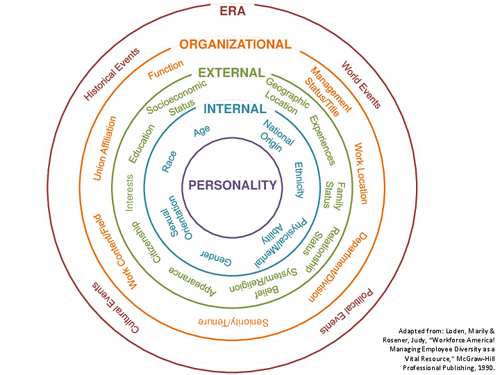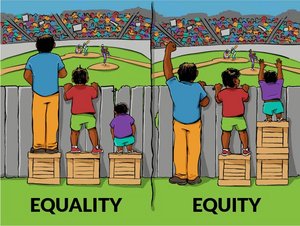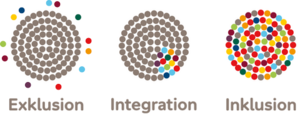Diversity
»Diversity« here refers to recognising and taking into consideration socially constructed and perpetuated forms of difference. This interpretation of the term emerged during the Black Civil Rights Movement in the USA, which aimed to establish equal opportunities and eliminate discrimination.
A corporate approach to the concept of diversity also developed in the USA, partly as a reaction to the legal ban on discrimination: »Diversity Management« is intended to use employees’ diversity for the benefit of corporate goals. »Diversity« is understood in this context as an economically profitable resource that can be managed.
Aspects of Diversity
Diversity has many characteristics and facets, such as gender, social or cultural background, age, physical and psychological disposition. There are visible and invisible aspects, as well as changeable, unchangeable, or difficult to change aspects. The »Diversity Wheel« in Figure 1 provides an initial overview of the various dimensions of diversity and their relationship to the individual.
The different aspects of diversity that make up each individual result in different experiences and perspectives. Depending on the social group to which they belong and the situation, individuals experience different forms of social positioning that expose them to certain forms of discrimination or endow them with certain social privileges. Furthermore, those who belong to multiple marginalised groups at the same time may be subject to multiple forms of discrimination.
When different dimensions of diversity or forms of discrimination come together like at a crossroads (»intersection«), overlap and interact, we speak of »intersectionality« (see Crenshaw, 1989, 1991). It is important here to note that the concept of intersectionality is not an additive model of social oppression. Instead, intersectionality refers to the specific forms of discrimination that individuals and groups experience as a result of different forms of discrimination/privilege interacting (for instance, Black women do not always experience racism in the same was as Black men do, and they do not always experience sexism in the same way as white women). Intersectionality challenges the widespread notion that sexism, heterosexism, racism, ableism, classism and other forms of dominance/subordination are separate systems. Rather, intersectionality understands these elements as fundamentally intertwined, supporting and reinforcing one another.
Socially traditional ideas about different social groups, their members and supposed characteristics and behaviours influence our perception, our expectations, our experiences and ultimately our behaviour towards these individuals or groups. It is therefore important that we critically reflect on our assumptions in order to avoid discriminating against others. The Diversity Department and the Equal Opportunity Office regularly offer workshops and events for students and teaching staff for this purpose.

Discrimination
Discrimination is the unjust distinction and production of differences between individuals based on characteristics that are specific to them, attributed to them and endowed with meaning; crucially, it also includes any resulting marginalisation, disadvantage and exclusion. Disadvantage can occur with regard to material and symbolic resources and/or social access and participation.
At the same time, discrimination establishes, maintains and strengthens the advantages and privileges held by the dominant groups and their members in terms of social status, access to resources, and opportunities for determining living conditions.
Discrimination can occur on various levels: (1) at the individual/interpersonal level, (2) at an institutional level, and (3) at a structural level. It can be intentional or unintentional. The intention of the person discriminating is not relevant, rather it is the effect of the discriminatory action on the individual being discriminated against that is important.
Equal Opportunities
The concept of creating equal opportunities recognises that each individual has different requirements that correspondingly different means and measures are required to open up the same opportunities for everyone. Removing barriers and providing resources helps ensure that people with different backgrounds and specific needs can participate equally in social (including university) life.
 (Accessible document)
(Accessible document)Inclusion
Inclusion means that social or spatial environments are designed in a way that everyone can participate equally and without restrictions. The term is used most often to refer to the participation of individuals with disabilities, but can also be used in a broader sense, i.e. as it relates to other groups that are discriminated against. In contrast to the concept of integration, which assumes that individuals must adapt to the system, the concept of inclusion assumes that the system must adapt to the individuals and their different requirements in order to enable actual participation and equal opportunities. By adapting the social or spatial environment to the needs of everyone, secondary exclusions, such as the social or spatial segregation of individuals or social groups with specific needs or experiences of discrimination, can also be avoided.
Literature
Crenshaw, Kimberlé (1989). Demarginalizing the intersection of race and sex: A Black feminist critique of antidiscrimination doctrine, feminist theory and antiracist politics. University of Chicago Legal Forum, 1989, 139–167.
Crenshaw, Kimberlé (1991). Mapping the margins: Intersectionality, identity politics, and violence against Women of Color. Stanford Law Review, 43(6), 1241–1299.
Dovidio, John F., Miles Hewstone, Peter Glick, & Victoria M. Esses (2010). Prejudice, Stereotyping and Discrimination: Theoretical and Empirical Overview. In John F. Dovidio, et al (Eds.), The SAGE Handbook of Prejudice, Stereotyping and Discrimination (pp. 3–28). Los Angeles: SAGE Publications.
Gomolla, Mechthild (2016). Diskriminierung. In Paul Mecherill (Ed.), Veronika Kourabas, & Matthias Rangger, Handbuch Migrationspädagogik (pp. 73–89). Weinheim & Basel: Beltz.
Kourabas, Veronika (2019). Glossar. Bedeutung und Anwendung zentraler Begriffe im Kontext der Rassismuskritik. In Land Nordrhein-Westfalen (Ed.), Arbeitspapier Denkanstöße für eine rassismuskritische Perspektive auf kommunale Integrationsarbeit Kommunale Integrationszentren NRW in den Kommunalen Integrationszentren – Ein Querschnittsthema (pp. 57–71). Arnsberg: Land Nordrhein-Westfalen. Retrieved from: www.stadt-muenster.de/fileadmin//user_upload/stadt-muenster/v_zuwanderung/pdf/Denkanstoesse_fuer_eine_rassismuskritische_Perspektive_finale_Fassung.pdf

